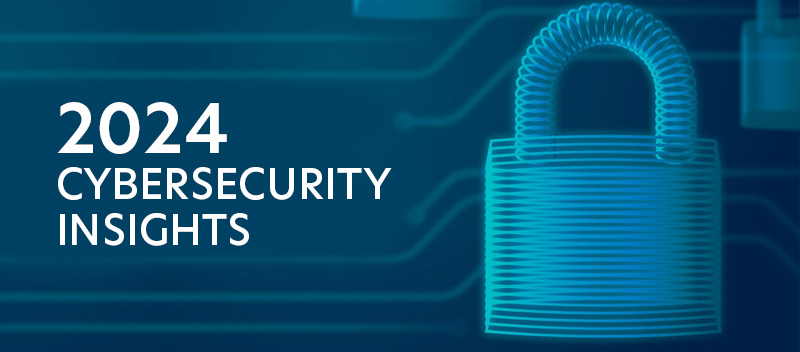Blog 2024 Cybersecurity Insights: Elevate Risk Management with Best Practices
2024 Cybersecurity Insights: Elevate Risk Management with Best Practices

Navigating the cybersecurity landscape in 2024 feels like steering a ship through ever-changing waters. New threats are emerging faster than ever, challenging even the most seasoned security professionals. For CISOs and IT strategists, staying ahead isn’t just beneficial — it’s crucial.
As cyber threats become more sophisticated, effective risk management strategies are your best defense. This blog post equips you with the latest best practices and innovative approaches to strengthen your organization’s risk management posture in 2024.
The Evolving Threat Landscape: Why We Need to Adapt
The threat landscape is not only evolving but doing so at a pace that requires constant vigilance. Here’s a closer look at what’s on the horizon and why adaptation is key:
Emerging Threats
-
- Deepfakes: These sophisticated digital forgeries have moved beyond novelty status, presenting significant threats. Misinformation campaigns are using them more and more often in an attempt to distort political processes or public opinion. By pretending to be executives during video chats, deepfakes can help commit fraud in the business sector and result in unapproved transactions or data breaches.
- Supply Chain Attacks: Attacks targeting software supply chains are particularly dangerous because they exploit existing trust relationships. By compromising a trusted supplier, attackers can inject malicious code into legitimate software updates, affecting numerous organizations before the breach is even detected. This ripple effect can lead to widespread data breaches and operational disruptions.
- Ransomware-as-a-Service (RaaS): This business model for cybercrime lowers the entry barrier for cybercriminals by providing ready-made ransomware tools to those without technical expertise. It allows attackers to execute sophisticated ransomware attacks with relative ease, targeting organizations of all sizes. The commoditization of ransomware increases the volume and complexity of attacks, making them a persistent threat.
Shifting Regulatory Landscape
The regulatory environment is in flux, with new data privacy regulations on the horizon that could significantly impact risk management practices. Laws that may impose more stringent rules for data management and reporting will need organizations to adjust.
To ensure data privacy and prevent severe penalties, these developments call for a review and potential revamp of present compliance practices. Retaining compliance and stakeholder and client trust requires being knowledgeable and flexible.
Remote Work Challenges
The shift to remote and hybrid work models continues to pose significant security challenges. Here’s what organizations need to focus on:
-
- Secure Device Management: With employees accessing company resources from personal devices, ensuring these devices are secure is paramount. Implementing policies for device encryption, regular updates, and endpoint protection can mitigate risks.
- Protecting Sensitive Data: Remote work increases the risk of data breaches, as sensitive information is accessed from various locations. Solutions such as virtual private networks (VPNs), multi-factor authentication, and data loss prevention tools are essential to safeguard data.
- Maintaining a Strong Security Posture: Ensuring a consistent security posture across various endpoints requires robust policies and continuous monitoring. Regular security training for employees can help reinforce a security-first mindset, reducing the likelihood of human error leading to security incidents.
Adapting to these changes isn’t optional — it’s essential for maintaining a robust cybersecurity posture. As threats and regulations evolve, so do our risk management strategies.
For more on our Cybersecurity Risk Assessment services
2024 Risk Management Best Practices
As we dive deeper into 2024, staying ahead in cybersecurity requires more than just keeping up with technology — it’s about adopting a new mindset. Here are some strategies that can truly make a difference:
1. Prioritize Proactive Measures
Let’s face it: reacting to threats after they’ve occurred is like closing the barn door after the horse has bolted. Proactive risk management is about anticipating issues before they arise. Regular risk assessments and vulnerability simulations can help pinpoint weak spots early. This approach not only bolsters your defenses but also instills confidence in your security strategy.
2. Continuous Threat Intelligence
Incorporating real-time threat intelligence into your risk assessments is no longer optional—it’s essential. By staying on top of global threat trends, you can tweak your defenses dynamically. This keeps your organization agile and ready to tackle potential threats head-on.
3. Zero Trust Architecture
Zero Trust isn’t just a buzzword — it’s a philosophy that’s reshaping cybersecurity. By assuming that every access request is potentially a threat, you enforce strict verification protocols. This means that even if a network is compromised, the damage is contained, keeping your critical assets safe.
4. Focus on People-Centric Security
Technology is just one part of the puzzle; people are the other. Cultivating a security-first mindset among your team is crucial. Regular training and awareness programs help employees recognize and avoid threats, turning them into your first line of defense against cyberattacks.
5. Invest in Automation and Orchestration
Automation and Security Orchestration Automation Response (SOAR) tools are transforming how we handle cybersecurity. They automate routine tasks and coordinate complex processes, giving your team more time to focus on strategic threats. This not only boosts efficiency but also shortens response times when incidents occur.
By embracing these best practices, you’re not just shielding your organization from the threats of 2024 — you’re building a resilient, forward-thinking security ecosystem.
Innovative Approaches to Elevate Risk Management
Here are some cutting-edge approaches that are reshaping risk management today:
— Artificial Intelligence (AI) and Machine Learning (ML)
AI and ML are revolutionizing cybersecurity by processing vast amounts of data to detect patterns and anomalies that are often missed by human analysts. AI in cybersecurity can swiftly predict potential threats before they escalate.
Meanwhile, machine learning fine-tunes these processes, learning from each interaction to enhance accuracy and effectiveness over time.
— Cybersecurity Mesh Architecture
For handling security in remote contexts, the Cybersecurity Mesh Architecture provides an adaptable and scalable approach. The ability of various security services to work together seamlessly is made possible by this method, which is essential as more businesses shift to remote work and cloud services.
Strong protection is provided across all network components by decentralizing security perimeters, which strengthens the overall security posture.
— Threat Modeling 2.0
As IT infrastructures become more complex, traditional threat modeling needs an upgrade. Threat Modeling 2.0 addresses the intricacies of modern systems by analyzing the interconnections of devices and networks.
This approach helps anticipate potential attack vectors, allowing for proactive defenses. Regularly updating these models ensures a dynamic and effective defense strategy.
These tactics transform our understanding of security and go beyond merely keeping up with technological developments. Businesses may fortify their defenses and create a more secure future by using these strategies.
Implementing Best Practices: Building a Robust Strategy
To create a strong defense against cyber threats, it’s crucial to implement best practices in risk management. Here’s how you can build a robust strategy:
Risk Assessment Methodology
Having a well-defined risk assessment methodology is essential for identifying vulnerabilities and potential threats. Regular and comprehensive risk assessments help organizations stay ahead of emerging risks. Best practices include:
-
- Conducting risk assessments at scheduled intervals and after significant changes in the IT environment.
- Involving cross-functional teams to ensure diverse perspectives and expertise.
- Utilizing qualitative and quantitative methods to evaluate risks accurately.
Integration with Business Continuity Planning
Integrating risk management with business continuity planning is vital for effective incident response. This ensures that your organization can quickly recover from disruptions. Key points to consider are:
-
- Aligning risk management strategies with business continuity objectives to support seamless operations.
- Conducting joint exercises to test and refine response plans.
- Ensuring communication channels are clear, and roles are well-defined during incidents.
Metrics and Measurement
Tracking risk management metrics is crucial for evaluating the success of your initiatives. By measuring key performance indicators, you can identify areas of improvement and demonstrate the value of your efforts. Consider the following:
-
- Establishing clear metrics that align with business goals and risk tolerance levels.
- Regularly reviewing these metrics to assess the effectiveness of risk management processes.
- Using metrics to inform decision-making and strategy adjustments.
By following these best practices, businesses can build a solid foundation for managing risks and ensuring resilience in the face of cyber threats.
TrustNet: Your Partner in Effective Risk Management
Risk management has swiftly become an essential business imperative as cyber threats grow increasingly sophisticated and hackers more determined.
TrustNet is your trusted partner in navigating these challenges, offering expert guidance and comprehensive risk management solutions tailored to fortify your defenses:
-
- Security Monitoring: Continuous oversight to detect and respond to potential threats promptly.
- Advanced Threat Management: Cutting-edge tools and strategies to manage and mitigate sophisticated cyber threats.
- Network Security: Comprehensive protection of your network infrastructure from unauthorized access and attacks.
- Vulnerability Management: Systematic identification and remediation of vulnerabilities to prevent exploitation.
- Compliance: Alignment with industry standards and regulations to ensure your organization meets all necessary compliance requirements.
- Cloud and Multi-Cloud: Integrated security solutions for cloud-based environments, ensuring seamless protection across all platforms.
With TrustNet’s risk management solutions, you gain a strategic ally committed to enhancing your security posture, empowering you to focus on your core business objectives with confidence.
Navigating the Evolving Threat Landscape
As the evolving threat landscape presents new challenges, organizations must stay agile, proactive, and resilient. TrustNet stands ready to support you in this journey, offering comprehensive solutions that empower your team to navigate these complexities with confidence.
TrustNet excels in transforming risk management into a strategic advantage. By leveraging our expertise and state-of-the-art solutions, your business can effectively safeguard critical assets, ensure operational continuity, and maintain a competitive edge. Our tailored approach ensures that every aspect of your security framework is robust, scalable, and aligned with your specific needs.
Transform your risk management strategy with TrustNet. Schedule a consultation today.




